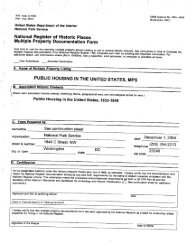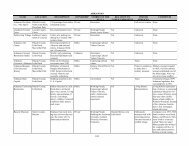Cultural Landscape Report for Charlestown Navy Yard, Boston
Cultural Landscape Report for Charlestown Navy Yard, Boston
Cultural Landscape Report for Charlestown Navy Yard, Boston
You also want an ePaper? Increase the reach of your titles
YUMPU automatically turns print PDFs into web optimized ePapers that Google loves.
YARD AND STREET NAMES<br />
INTRODUCTION<br />
Known variously as the <strong>Boston</strong> <strong>Navy</strong> <strong>Yard</strong> or <strong>Charlestown</strong> <strong>Navy</strong> <strong>Yard</strong> throughout its history, the yard officially<br />
became the <strong>Boston</strong> Naval Shipyard in 1945, shortly after the end of World War II. When starting in World War I,<br />
the yard acquired additional storage, docking, and repair facilities in South <strong>Boston</strong>, East <strong>Boston</strong>, and Chelsea, the<br />
<strong>Charlestown</strong> yard was referred to as the “main yard.” When the property became a national park site, Congress<br />
designated it as <strong>Charlestown</strong> <strong>Navy</strong> <strong>Yard</strong>. 2 The naval operations that continue within the <strong>Charlestown</strong> <strong>Navy</strong> <strong>Yard</strong><br />
are known as the Naval Historical Center Detachment <strong>Boston</strong>’s Maintenance & Repair Facility. In this report the<br />
site is referred to as the <strong>Charlestown</strong> <strong>Navy</strong> <strong>Yard</strong>, or simply the “yard.”<br />
Some of the surrounding streets names have changed since their seventeenth and eighteenth century origins.<br />
Chelsea Street was previously known as the Salem Turnpike, and the first road to the site was referred to as the<br />
“Lane to the Brickyards.” Early roads that led to Gates 1 and 2 of the yard—Water, Wapping, and Henley Streets—<br />
were subsequently eliminated and replaced by Constitution Road, which approaches Gate 1 along the <strong>for</strong>mer<br />
alignment of Water Street. Within the yard, the first road extended east from Henley Street and was known as New<br />
Road until it became Main Avenue in 1857. In the 1860s when railroad tracks were introduced to the yard, the<br />
waterfront road became the principal street called First Avenue, and Main Avenue became Second Avenue. In the<br />
1870s, the <strong>Navy</strong> assigned letters to the avenue names with First Avenue being Avenue E and Second Avenue being<br />
Avenue D. In 1902, to aid in yard organization, the <strong>Navy</strong> officially named roads running east-west as “Avenues” in<br />
numerical order from south to north, and roads running north-south as “Streets” in numerical order from west to<br />
east. 3<br />
BUILDING, STRUCTURE, AND PIER NAMES<br />
Beginning in the late 1860s, the <strong>Navy</strong> assigned a number or letter to each building, structure, and pier.<br />
Un<strong>for</strong>tunately, during major periods of development of the yard, such as in 1900 and the 1940s, some renumbering<br />
occurred. Similarly, building functions changed resulting in new descriptive names, such as the Dry Dock Engine<br />
House that now serves as the USS Constitution Museum (Building 22). In this report the descriptive name of the<br />
building or structure is paired with its numerical name in parenthesis to minimize confusion, e.g., the Paint Shop<br />
(Building 125). Appendix 1 lists the proper names, numbers, and locations of buildings and structures referenced in<br />
this report. Military documents typically capitalize the names of buildings, such as Dry Dock 1 and the<br />
Commandant’s House (Quarters G). In keeping with this tradition, most building and major structure names are<br />
capitalized in this report.<br />
The earliest piers were termed “wharves” and the two located at the western end of the yard were known as White’s<br />
Wharf and Shear Wharf. In the early 1900s, when the <strong>Navy</strong> extended the bulkhead line further into the harbor,<br />
many of the wharves were extended and thereafter referred to as piers. The piers are numbered from one to eleven,<br />
with Pier 1 on the western end of the yard. When closed in 1974, there were three dry docks in the yard, known as<br />
Dry Docks 1, 2, and 5. Dry Docks 3 and 4 were located in the South <strong>Boston</strong> Annex, which was active during World<br />
War II.<br />
For more in<strong>for</strong>mation on names, refer to Carlson, HRS, 2, f3.<br />
For more in<strong>for</strong>mation on building numbers and street names, refer to Carlson, HRS, 11, f17.<br />
2<br />
3<br />
page 7







